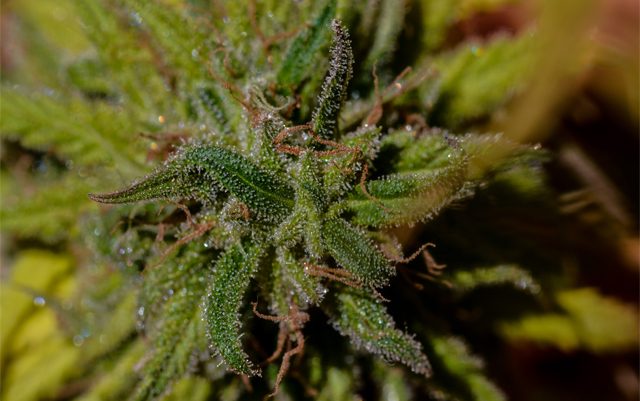Are the craft beer and wine appellation models really the future of cannabis branding, as some experts speculate? Perhaps no one knows better than Harris Damashek, a cannabis industry marketing veteran with unique credentials.
Before he headed up the design and launch of The Botanist chain of dispensaries for industry giant Acreage Holdings, he was global brand and creative director for Anheuser-Busch’s craft beer portfolio, now the world’s largest. Altogether, he has two decades of experience in consumer product design, branding, and marketing.
In an interview with The Marijuana Times just weeks after stepping down as Acreage’s chief marketing officer, Damashek said he finds some branding similarities between beer and cannabis. Successful craft beers are often built on one or more of three elements: face, place, and story. Think Samuel Adams or Sierra Nevada. Think Leafs by Snoop (Dogg) or Purple City Genetics in Oakland, California. (Purple is a euphemism for marijuana.)
Unlike cannabis, beer for the entire country is produced in a few central facilities. Anheuser-Busch operates 12 mega-breweries in the U.S. As a result, a bottle of branded beer tastes the same in L.A. as it does in New York. Marketing is regional or national, it’s consistent, and thus easily scalable.
Cannabis brands enjoy none of those advantages, plus they have to navigate a jungle of predators and pitfalls. They are primarily hobbled by multiple layers of regulation – state by state, county by county, sometimes town by town. “You need to create a separate marketing platform for each state,” says Damashek. “Packaging language differs state by state. Advertising rules differ. It’s at least as challenging as the pharmaceutical industry.”
On top of it all, the consumer is a fast-moving target. The first market – early adopters, in marketing lingo – has been largely made up of so-called legacy users: long-term smokers and aficionados. When he first joined Acreage two years ago, the stoner stigma associated with marijuana was still so prevalent that Damashek says, “It took me three months to tell my mother where I was working.”
Now, mainstream consumers are becoming the primary target – known in parlance as the “early majority”- and the emphasis is shifting away from recreational use. He says consumer research and recent market trends signal that the emerging mainstream consumer “is interested in cannabis in a very different way. Getting high is secondary to pain, insomnia, anxiety, stress, and sexual health. That is a tectonic shift in the types of products and brands you want to create.”
As the consumer market matures, so is the branding process. The first wave of branders, “were bunches of people in rooms coming up with fun, cool names and trying to make a go of it.” Now, he says, people with expertise in more traditional marketing categories – like his own – are being attracted to the industry because consumers are embracing cannabis as a health and wellness product, a global category pegged at more than $4 trillion a year.
Although there is a lot of interest today in crafted strains of flower, Damashek says the big bang is going to be in products that are identified with purpose, solutions, and affinity groups. He cites as an example dosist, a Santa Monica-based maker and marketer of a proprietary metered vape pen that measures out doses of different cannabis formulations.
The company originally branded the pen the hmbldt™ (as in Humboldt County, home of outlaw growers) but updated it in 2017 to its current, medicinal-sounding name. Instead of quirky, non-descriptive formulation names – like Blue Fire or Oregon Silver Haze – the dosist cartridges come in six moods, in understated packaging, prominently labeled: “bliss”, “sleep”, “calm”, “relief”, “arouse”, and “passion”.
Damashek says the system’s appeal is in its simplicity. It’s easy to understand for newbies; the product promises specific results so consumers can control how high they get; it communicates consistency across markets (like beer); and it appeals to consumers with high disposable incomes. Although dosist is only available in California and Florida so far, Damashek notes the company’s vape cartridges sell at a healthy premium compared to typical cartridges.
Another early branding breakout he mentioned is Lowell Herb Co., which markets a line of pre-rolled joints in packaging and marketing materials reminiscent of a cigar counter in a 19th century tobacconist shop. It’s a pitch that has dovetailed with the recent revival of the Levi’s brand among younger consumers connecting with authenticity.
Lowell’s packaging highlights its local sourcing: “We grow our flowers with only organic fertilizer.” The logo features a minotaur (a mythical half man, half bull creature) wearing a vest, resting on the handle of a shovel. Describing the packaging in The New Yorker, Dana Goodyear wrote that it “evokes a Works Progress Administration mural.”
Lowell’s also has a compelling story. The company has actively recruited employees who are parolees convicted of nonviolent marijuana-related crimes.
Damashek says the cannabis branding race is in its early stages, encumbered by all the rules and cross-currents of an unsettled legal landscape. He uses Coke to illustrate the point. “Imagine if, to create a bottle of Coke, in each state you had to grow the sugar cane and you couldn’t use it in any other state; you had to process it within each state; you had to package it to meet each state’s regulations; and so on.”
Until state and federal laws are reformed, which appears unlikely before 2021, he says the industry leaders with the deepest pockets will continue to compete mainly on size, buying up smaller brands and other assets in the rush to get as big as possible as fast as possible.






